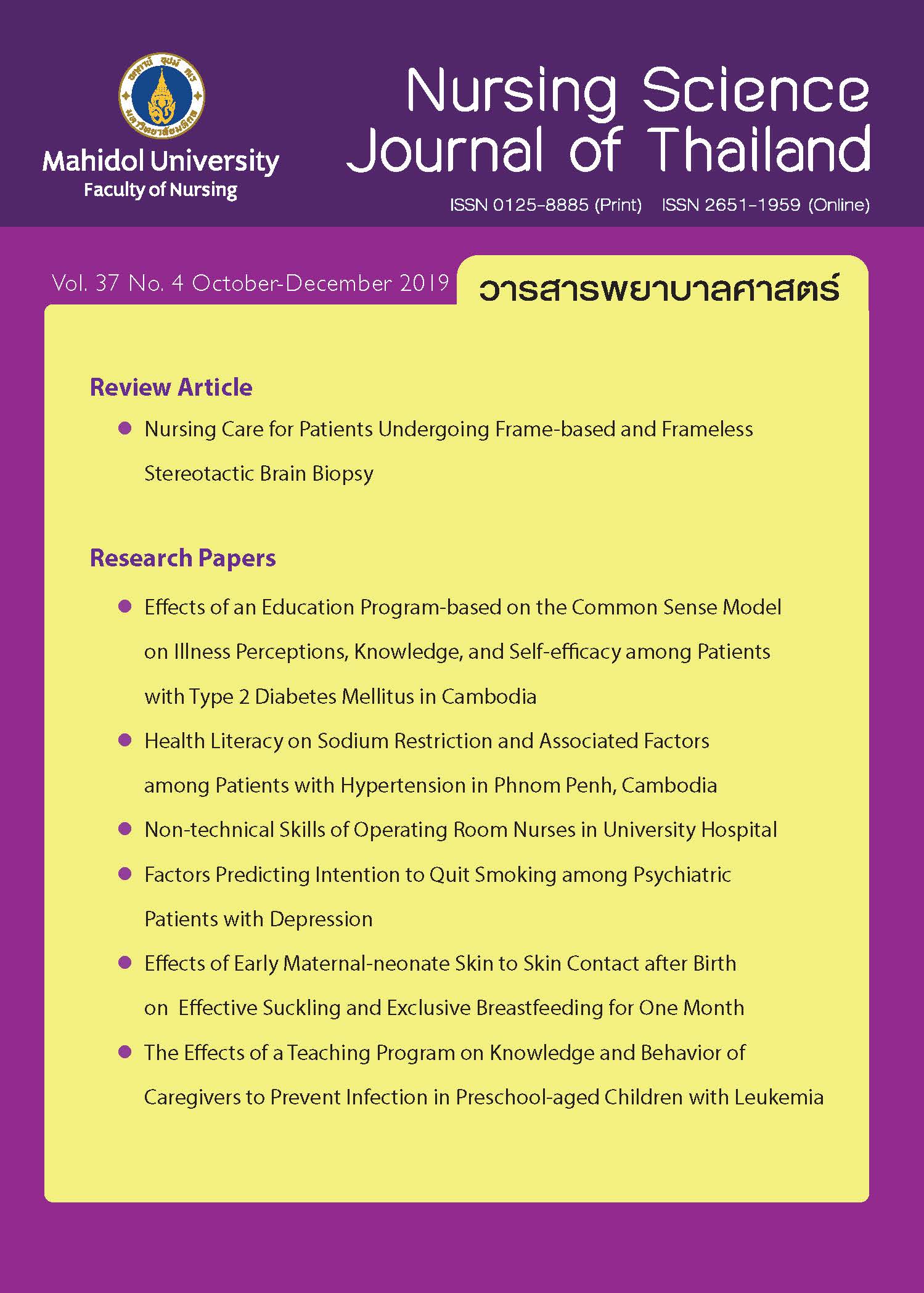Effects of Early Maternal-neonate Skin to Skin Contact after Birth on Effective Suckling and Exclusive Breastfeeding for One Month
Main Article Content
Abstract
Purpose: To examine the effects of early maternal-neonate skin to skin contact after birth on effective suckling at discharge and exclusive breastfeeding for 1 month.
Design: Randomized controlled trial design (double blind trails).
Methods: The participants were 59 dyads of mothers and their healthy neonates. Eligible mothers included: being primiparous women aged 18 years and above but below 35 years, having full-term pregnancy, and having normal delivery at a public hospital in Bangkok. Sixty-four mother-infant dyads were randomly assigned into two study groups but finally 30 dyads remained in the control group and 29 in the experimental group. The control group received routine nursing care. The experimental group received early maternal-neonate skin to skin contact within 5 minutes after birth for at least 1 hour. Data collection used five research instruments including the Demographics Interview Form, Labor Record Form, the Infant’s Feeding Record Form, the Effective Suckling Assessment Form, and the Infant’s Feeding Interview Form. Data were analyzed using descriptive statistics and chi-square test.
Main findings: The experimental group had a proportion of neonates with effective suckling at discharge statistically and significantly higher than that of the control group (p < .05). However, exclusive breastfeeding rate for 1 month in experimental group was not significantly different.
Conclusion and recommendations: Midwifes should apply early maternal-neonate skin to skin contact for at least 1 hour to initiate breastfeeding in order to enhance effective suckling at discharge.
Article Details
Copyright Notice: Nursing Science Journal of Thailand has exclusive rights to publish and distribute the manuscript and all contents therein. Without the journal’s permission, the dissemination of the manuscript in another journal or online, and the reproduction of the manuscript for non-educational purpose are prohibited.

Disclaimer: The opinion expressed and figures provided in this journal, NSJT, are the sole responsibility of the authors. The editorial board bears no responsibility in this regard.
References
2. World Health Organization. Kangaroo mother care: a practical guide. Geneva: World Health Organization; 2003. 48 p.
3. Patel RR, Liebling RE, Murphy DJ. Effect of operative delivery in the second stage of labor on breastfeeding success. Birth. 2003;30(4):255-60. doi: 10.1046/j.1523-536x.2003.00255.x
4. Varendi H, Porter RH. Breast odour as the only maternal stimulus elicits crawling towards the odour source. Acta Paediatrica. 2001;90(4):372-5.
5. Widstrom AM, Lilja G, Aaltomaa-Michalias P, Dahllof A, Lintula M, Nissen E. Newborn behaviour to locate the breast when skin-to-skin: a possible method for enabling early self-regulation. Acta Paediatrica. 2010;100(1):79-85. doi: 10.1111/j.1651-2227.2010.01983.x.
6. Dani C, Cecchi A, Commare A, Rapisardi G, Breschi R, Pratesi S. Behavior of the newborn during skin-to-skin. J Hum Lact. 2015;31(3):452-7. doi: 10.1177/0890334414566238.
7. Gangal P, Bhagat K, Prabhu S, Nair R. Breast crawl: initiation of breastfeeding by breast crawl [Internet]. Mumbai, India: UNICEF India; 2007 [cited 2017 Jan 8]. Available from: http://www.breastcrawl.org/pdf/breastcrawl.pdf.
8. Mahmood I, Jamal M, Khan N. Effect of mother-infant early skin-to-skin contact on breastfeeding status: a randomized controlled trial. J Coll Physicians Surg Pak. 2011;21(10):601-5. doi: 10.2011/JCPSP.601605.
9. Girish M, Mujawar N, Gotmare P, Paul N, Punia S, Pandey P. Impact and feasibility of breast crawl in a tertiary care hospital. J Perinatol. 2013;33(4):288-91. doi: 10.1038/jp.2012.109.
10. Lara-Cinisomo S, McKenney K, Di Florio A, Meltzer-Brody S. Associations between postpartum depression, breastfeeding, and oxytocin levels in Latina mothers. Breastfeed Med. 2017;12(7):436-42. doi: 10.1089/bfm.2016.0213.
11. Winberg L. Mother and newborn baby: mutual regulation of physiology and behavior-a selective review. Dev Psychobiol. 2005;47(3):217–29. doi: 10.1002/dev.20094.
12. The WHO Reproductive Health Library. WHO recommendation on skin-to-skin contact during the first hour after birth [internet]. Geneva: World Health Organization; 2018 [cited 2018 Oct 6]. Available from: https://extranet.who.int/rhl/topics/newborn-health/care-newborn-infant/who-recommendation-skin-skin-contact-during-first-hour-after-birth.
13. Moore ER, Bergman N, Anderson GC, Medley N. Early skin-to-skin contact for and their healthy newborn infants. Cochrane Database Syst Rev. 2016;11:CD003519. doi: 10.1002/14651858.CD003519.pub4.
14. Vaidya K, Sharma A, Dhungel S. Effect of early mother-baby close contact over the duration of exclusive breastfeeding. Nepal Med Coll J. 2005;7(2):138-40.
15. Wongphinit U, Sinsuksai N, Yusamran C. Personal factors, social support and effective suckling at discharge in predicting exclusive breastfeeding at one month among first-time mothers. Journal of The Royal Thai Army Nurses. 2016;17(1):88-95. (in Thai).
16. Essa RM, Ismail NIA. Effect of early maternal-newborn skin-to-skin contact after birth on the duration of third stage of labor and initiation of breastfeeding. J Nurs Educ Pract. 2015;5(4):98-107. doi: 10.5430/jnep.v5n4p98.
17. Moore ER, Anderson GC. Randomized controlled trial of very early mother-infant skin-to-skin contact and breastfeeding status. J Midwifery Womens Health. 2007;52(2):116-25. doi: 10.1016/j.jmwh.2006.12.002.
18. Gerd AT, Bergman S, Dahlgren J, Roswall J, Alm B. Factors associated with discontinuation of breastfeeding before 1 month of age. Acta Paediatr. 2012;101(1):55-60. doi: 10.1111/j.1651-2227.2011.02405.x.


